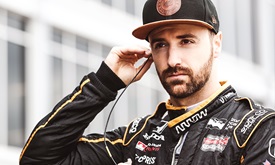ISM Raceway event offers glimpse at future of short track racing
APR 10, 2018
Before the SunTrust Indy Challenge at Richmond International Raceway in 2005, Tony Kanaan joked about his last-place starting position. He’d crashed in qualifying, negating what could have been a pole position, and was forced to start 22nd.
The jokes were about how many cars he could pass in the early laps, and they turned out to carry more truth than hyperbole. Kanaan passed half the field in the opening minutes, working his way into contention before a crash ended his day.
That race 13 years ago came during an era considered by some to be the heyday of short-oval racing in Indy car racing. Cars turned laps side-by-side, lap after lap. It was entertaining. It was edge-of-the-seat stuff. Richmond in 2005 also turned into a messy crashfest. Sometimes, that style of short-oval racing isn’t as romantic as we make it out to be.
Which brings us to Saturday night’s Desert Diamond West Valley Casino Phoenix Grand Prix at ISM Raceway and the way short-oval racing is now. The first oval race of the new 2018 Indy car was the antithesis of 2005 Richmond. Nobody was passing most of the field in a few laps, and a new leader wasn’t emerging every other lap.
Afterward, the general consensus on social media considered Saturday’s race a dull affair. Not enough passing, they said. Not enough action. Not enough back and forth.
But what it lacked in mid-2000s Richmond wildness was made up in strategy, and what it gave us at the end was tantalizing drama. When Josef Newgarden pitted under caution with 18 laps remaining, it became clear that the primary question -- the entertainment of it all -- was whether he could catch leader Robert Wickens, who had stayed out during the caution to preserve track position.
So, instead of the thrill of side-by-side on-track action, we got a twofer: pit strategy and on-track action. Thanks to the new universal aero kit, we’ve regained an element. This early experiment of the low-downforce era showed an overall look of short-track drama. It showed something new.
In the end, Phoenix contained sharp calls and brash moves and remarkable driving. It had an astonishing run by Alexander Rossi, a bold attempt by Robert Wickens and a strong effort from Sebastien Bourdais. It had a record 12 lead changes among nine drivers and only two cautions.
And it had that fearless pass by Newgarden.
“The last pass was risky,” Newgarden said afterward. “I didn't know how that was going to go. The first one I felt pretty confident in. I analyzed it. I was, like, ‘I think that will work.’ It was premeditated. The last one, I didn't know I had to do that. When I was sizing him up, I was like, ‘Man, this is the only way this is going to work out.’ I didn't know if it was going to work, but it was good.”
It was good, and not just the pass. The complaints about one-groove racing overlook the other positive elements. Considering how critical short ovals are to the future, it’s essential that the Saturday’s race from an all-encompassing lens. Short ovals have potential as long as we don’t see them as we saw Richmond back in the day.
Short tracks play an important role in the venue diversity that makes this sport unique. They are the fourth leg of the stool, yet they don’t appeal to everyone. The future of Phoenix, Iowa and Gateway lies with the new kit fitting the venue. If it adds an extra dimension at ISM, there is reason to hope it will add an extra dimension at Iowa and Gateway.
Phoenix wasn’t impeccable, but it also wasn’t a mess. It showed that drivers can’t just mat it and go to the front. It showed that strategy and pit stops and decisions are as much a part of the game as driving. It showed something different, something we’re not always used to seeing.
Not a classic, but perhaps a meaningful look into the future.



















